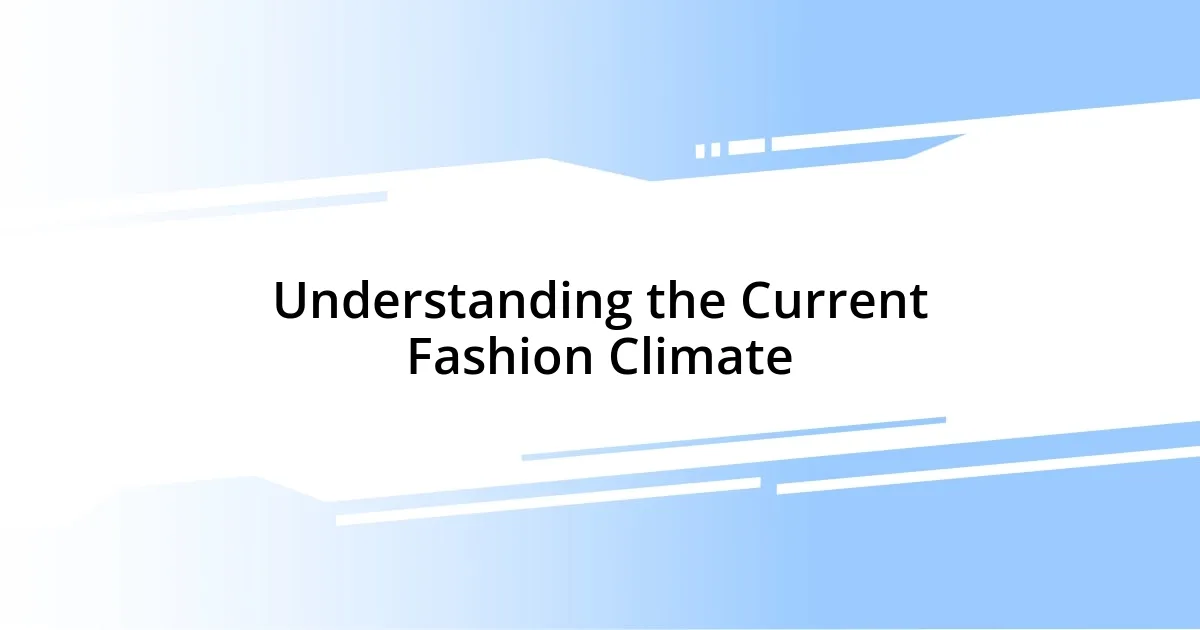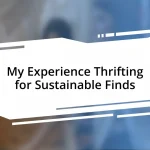Key takeaways:
- The fashion industry is experiencing a shift towards sustainability, yet fast fashion remains prevalent, raising ethical dilemmas for consumers.
- Identifying unsustainable practices involves recognizing signs like low-cost production, fast cycles, and lack of transparency in brands.
- Engaging in community initiatives and collaborating with local organizations can amplify advocacy efforts and foster a sense of shared responsibility.
- Measuring the impact of advocacy is crucial; focusing on genuine behavioral changes among consumers reflects the effectiveness of initiatives.

Understanding the Current Fashion Climate
The fashion climate today is a complex tapestry woven from cultural shifts, technological advancements, and a growing awareness of sustainability. I remember attending a local fashion show where the designer passionately discussed the importance of eco-friendly materials. It struck me how much raw talent can be harnessed responsibly, but then I wondered—how many consumers really grasp the impact of their choices?
There’s an incredible push towards ethical practices, yet the fast fashion industry continues to thrive, often overshadowing these efforts. I once found myself in a store, overwhelmed by racks of clothing priced so low, I couldn’t help but think about the hidden costs. Isn’t it fascinating how a bargain can come with moral dilemmas that we might overlook in our quest for affordability?
As I navigate discussions around fashion these days, it’s clear that consumers are becoming more conscious. I recall a lively debate with friends about whether we could go a month without buying anything new. Those conversations are enlightening—aren’t we at a pivotal moment where our values could truly reshape the industry?

Identifying Unsustainable Fashion Practices
Identifying unsustainable fashion practices can feel daunting, but a few clear signs can help in this cause. For instance, I often check labels and notice how many garments contain synthetic materials, which can take decades to decompose. It’s disheartening to think that our choices can lead to long-term environmental consequences.
Here are some telltale indicators of unsustainable fashion practices:
- Low-cost production: Clothing priced significantly below average likely sacrifices quality and ethics in manufacturing.
- Fast production cycles: Frequent trends and rapid turnover in collections often mean exploitation of labor and resources.
- Lack of transparency: Brands that don’t disclose their supply chain or sourcing practices may hide unsustainable practices.
- Poor quality materials: garments that fall apart after a few wears signal not only poor craftsmanship but also wastefulness in consumption.
When I look into my wardrobe, I can’t help but remember an old favorite dress that I wore until it frayed, which sparked my realization about quality over quantity. That experience was a turning point for me—it made me appreciate the stories behind sustainable fashion, which often come with conscious choices rather than fleeting trends.

Researching Ethical Fashion Brands
Researching ethical fashion brands isn’t just about checking labels; it’s about digging deeper into brand narratives. I remember the moment I discovered a little-known brand that crafted beautiful garments from recycled materials. As I scrolled through their website, I felt a sense of connection, seeing how each piece came with a story of sustainability and social responsibility. It was enlightening to realize that many brands genuinely strive to make a difference, but this requires vigilance from consumers like us.
One approach I take is reading customer reviews and advocacy articles to understand a brand’s reputation. I once stumbled across an article highlighting a brand’s fair trade practices, where artisans were paid fairly and treated with respect. That made me consider how my purchasing power could support such admirable efforts. Comparing brands side by side, especially their commitments to ethical labor practices and environmental impact, can reveal profound differences that influence my choices.
Ultimately, my goal is to align my wardrobe with my values. I often compile lists of preferred brands, noting their certifications, which might include Fair Trade or GOTS (Global Organic Textile Standard) – an assurance of ethically sourced and manufactured textiles. Whenever I make a purchase, I think of the artisans behind the scenes. This process feels empowering; it reminds me that I’m not just buying clothes but investing in better practices for the future.
| Brand | Features |
|---|---|
| Brand A | Fair Trade certified, eco-friendly materials, transparent supply chain |
| Brand B | Recycled fabrics, local artisans, empowers communities |
| Brand C | Vegan options, sustainable dyes, commitment to zero waste |

Implementing Sustainable Wardrobe Choices
Making sustainable wardrobe choices is something I approach with intention and mindfulness. I recall a moment when I decided to revamp my closet by shopping only from thrift stores for an entire month. The thrill of discovering unique pieces was exhilarating, and I realized that each garment had its own history, contributing to a more sustainable approach. Doesn’t it feel good to know you’re not only saving money but also giving clothes a second life?
I often evaluate my purchases by contemplating the longevity of the items and their versatility. A few years ago, I invested in a high-quality pair of jeans that I still wear regularly, while fast fashion garments I bought around the same time already gave out. This experience reinforced my belief that investing in fewer, high-quality pieces is not just comforting but smart. Plus, have you ever noticed how much better you feel wearing something that fits perfectly and is made to last?
When I think about implementing sustainable choices, it’s also about curating my wardrobe deliberately. I’ve started a “one-in, one-out” policy, ensuring that for every new clothing item I bring home, I donate or recycle an old one. It’s liberating and reminds me that minimalist practices can coexist with personal expression. How do you approach your wardrobe choices? I find that this method encourages me to really appreciate what I own while contributing positively to the cycle of fashion. It’s all about balance, and adopting sustainable habits offers a rewarding journey in our fashion choices.

Raising Awareness Through Social Media
Raising awareness through social media has become a powerful tool for advocating better fashion practices. I vividly remember when I shared a post about the harmful impacts of fast fashion on my Instagram stories. The feedback was incredible—friends were reaching out, asking for resources and tips on how to shop more sustainably. It was rewarding to spark conversations that went beyond likes and shares, turning a simple post into a collective effort toward change.
Engaging with my audience has shifted my perspective on the responsibility that comes with having a platform. I often create polls and ask my followers what ethical brands they support, and I invite them to share their stories. This exchange not only builds a community but also educates everyone involved. For instance, I was surprised to learn about a brand that a follower adored, which focuses on upcycling materials. It felt like uncovering a treasure chest of knowledge we could all benefit from.
Additionally, I love utilizing hashtags to spread awareness and connect with like-minded advocates. A few months back, I stumbled upon #SustainableFashionChallenge, and it encouraged me to post daily outfits that highlighted my commitment to eco-friendly choices. Each post was an opportunity to inspire, and one friend even told me that it motivated her to rethink her own fashion habits. Have you ever participated in a challenge that sparked a passion for something you cared about? For me, these moments reaffirm the impact of social media—it has the potential not just to influence purchases but to cultivate a community dedicated to change.

Collaborating with Local Organizations
Collaborating with local organizations has been a transformative aspect of my journey in advocating for better fashion practices. I remember attending an event hosted by a local non-profit focused on sustainable fashion. Connecting with like-minded individuals in my community not only broadened my knowledge but also sparked inspiring ideas for joint initiatives. Have you ever found that collaboration amplifies your efforts? I certainly have.
One memorable experience was a clothing swap organized in partnership with a neighborhood group. We transformed a community center into a vibrant space where people exchanged garments while sharing stories behind their items. The energy was contagious, and each item held a narrative—how empowering it was to see firsthand the joy of sustainability and togetherness! It made me realize that every piece of clothing has a value beyond its price tag.
Working alongside local organizations also allows me to support ethical brands that align with our values. Recently, I collaborated with a small local boutique committed to fair trade practices for an awareness campaign. It was fulfilling to see the community come together, sharing our passion and knowledge about ethical fashion. Have you experienced the power of collective action in your advocacy efforts? Those moments reinforce my belief that together, we can create a significant impact and inspire others to make conscious choices.

Measuring Impact and Building Community
Measuring impact in the fashion advocacy space often feels like piecing together a puzzle. When I started tracking engagement metrics on my initiatives, I was amazed to see the ripple effects of our collective efforts unfold. For example, after hosting a webinar on sustainable practices, I received a flood of messages from participants telling me they had since switched to shopping secondhand. It’s rewarding to witness tangible changes, knowing my work prompted those decisions, but it also encourages me to dig deeper into what really drives our community’s actions.
Building community means fostering meaningful connections that go beyond surface-level interactions. I recall a potluck I organized, inviting local advocates to share their favorite sustainable dishes alongside stories of their fashion journeys. The warmth in that room was palpable, and I realized that it’s not just about the clothes we wear but the stories tied to them. Each dish served was a reminder that our choices are intertwined with our identities. Have you ever experienced such heartwarming connections? Those moments inspire and energize my commitment to the cause.
Finding metrics that matter is essential for growth and encouragement. I’ve learned to focus less on likes and shares, and more on how many people actually change their habits after my campaigns. Once, I created a monthly challenge where participants would document one sustainable choice they made. The enthusiasm was contagious, and seeing others champion small wins reaffirms the impact we can have when we rally together. In what ways do you measure success in your advocacy? It’s these shared victories that fuel my passion and help cultivate a thriving community dedicated to better fashion practices.














